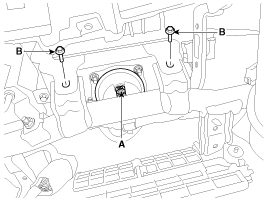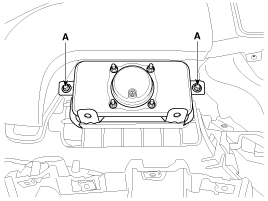 Hyundai Veloster: Passenger Airbag (PAB) Module. Repair procedures
Hyundai Veloster 2011-2017 Service Manual / Restraint (Depowered) / Airbag Module / Passenger Airbag (PAB) Module. Repair procedures
Hyundai Veloster: Passenger Airbag (PAB) Module. Repair procedures
Hyundai Veloster 2011-2017 Service Manual / Restraint (Depowered) / Airbag Module / Passenger Airbag (PAB) Module. Repair procedures
Hyundai Veloster 2011-2017 Service Manual / Restraint (Depowered) / Airbag Module / Passenger Airbag (PAB) Module. Repair procedures
Removal
| 1. |
Disconnect the battery negative cable and wait for at least three
minutes before beginning work.
|
| 2. |
Remove the glove box housing.
(Refer to the Body group - "Crash pad")
|
| 3. |
Disconnect the passenger airbag connector (A) and remove the PAB
mounting bolt (B).
|
| 4. |
Remove the crash pad.
(Refer to the Body group - "Crash pad")
|
| 5. |
Remove the mounting bolts from the crash pad. Then remove the
passenger airbag.
|
Installation
| 1. |
Remove the ignition key from the vehicle.
|
| 2. |
Disconnect the battery negative cable from battery and wait for
at least three minutes before beginning work.
|
| 3. |
Place a passenger airbag on the crash pad and tighten the passenger
airbag mounting bolts.
|
| 4. |
Install the crash pad.
(Refer to the Body group - "Crash pad")
|
| 5. |
Tighten the passenger airbag mounting bolts.
|
| 6. |
Connect the passenger airbag harness connector to the SRS main
harness connector.
|
| 7. |
Reinstall the glove box housing.
(Refer to the Body group - "Crash pad")
|
| 8. |
Reconnect the battery negative cable.
|
| 9. |
After installing the passenger airbag (PAB), confirm proper system
operation:
|
 Side Airbag (SAB) Module. Description and Operation
Side Airbag (SAB) Module. Description and Operation
Description
The Side Airbags (SAB) are installed inside the front seat and protects
the driver and passenger from danger when side crash occurs. The SRSCM determines
deployment of side airba ...
See also:
SRS Control Module (SRSCM). Components and Components Location
Components
...
Passive Occupant Detection System (PODS-F). Components and Components Location
Components
...
DCT Control Modle (TCM) > Description and Operation
Description
The Transmission Control Module (TCM) is like the brain for the DCT. It
receives information from various sensors for a wide range of transmission controls
to provide an optimal ...
Categories
- Hyundai Veloster Manuals Home
- Hyundai Veloster 2010-2017 Owner's Manual
- Hyundai Veloster 2010-2017 Service Manual
В© 2011-2025 Copyright www.hvmanual.com



